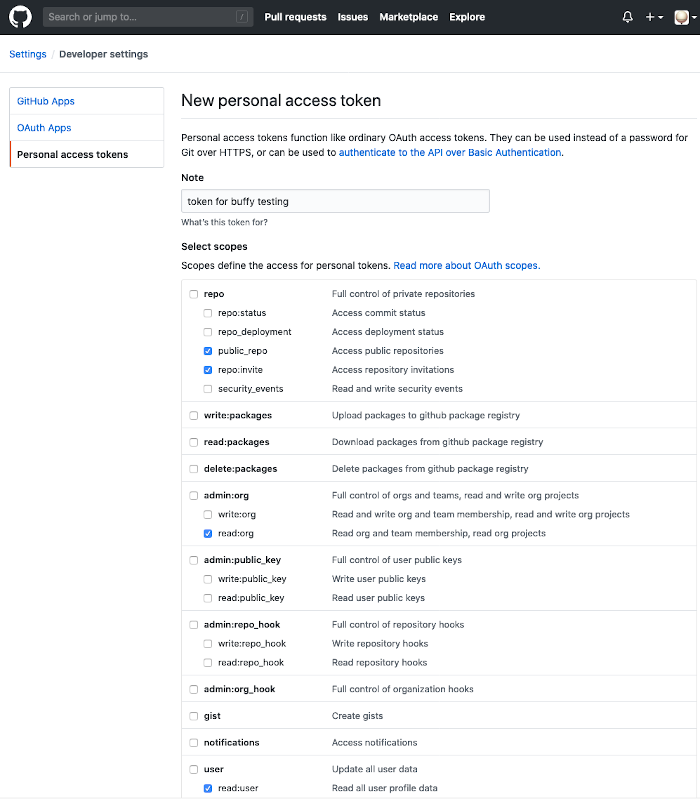Installation
Buffy works listening to events received from GitHub and deciding if/how to reply by passing the received payload to different Responders. You can fork Buffy and configure the responders you want to use for any specific repository. There is no need for the Buffy fork to be located in the same GitHub user/organization as the repo where it will be used. To have Buffy ready and listening to events you can install it locally or deploy it to a server or service platform. You’ll need the following components:
A GitHub user to use as the bot with admin permissions on the target repo (usually a member of the organization owning the repo).
An instance of Buffy running
A webhook configured in the GitHub repo’s settings to send events to Buffy
Create the bot GitHub user
This will be the user responding to commands in the reviews repo.
1. Sign up at GitHub and create the bot user:
 GitHub's signup page
GitHub's signup page
2. Go to Settings >> Developer settings >> Personal access tokens and create a new token with these scopes: public_repo, repo:invite, read:org, read:user and, if using the approval responder, admin:org (as the app will create teams and invite members to the ropensci organization). Save that token, it will be your BUFFY_GH_ACCESS_TOKEN.
 Settings >> Developer settings >> Personal access tokens
Settings >> Developer settings >> Personal access tokens
3. Give the bot admin permissions: add it as member of the organization owning the repo where the reviews will take place:
 People at GitHub Organization
People at GitHub Organization
Deploy Buffy
Server requirements
Some applications and services must be available to use by Buffy:
Redis: To process background jobs Buffy needs
redisinstalled.Gitinspector: The Respository Checks Responder performs a statistical analysis using it.
cloc: The Respository Checks Responder can analyze source code, to run this check
clocis used.
Deployment
We will use here Heroku as an example service to deploy Buffy but you can use any other server or platform.
1. Create a new app in heroku linked to the url of your fork of Buffy. Automatically Heroku will use the heroku/ruby buildpack.
To process background jobs Buffy needs
redisinstalled, several add-ons providing it are available: Heroku Redis, RedisGreen, Redis To Go, etc.To install the
clocdependency there’s a buildpack for Heroku available here.Gitinspector can be installed using npm. To do so in Heroku, the
heroku/nodejsbuildpack can be added.
2. In the app settings add the following Config Vars:
BUFFY_BOT_GH_USER: <the_github_username_of_the_bot>
BUFFY_GH_ACCESS_TOKEN: <the_access_token_for_the_bot_created_in_the_previous_step>
BUFFY_GH_SECRET_TOKEN: <a_random_string>
RACK_ENV: production
2b. You can set the Ruby version to install using the CUSTOM_RUBY_VERSION env var. Unless you need any other specific version, please add also a Config Var named CUSTOM_RUBY_VERSION with the value of the latest version listed in the Buffy tested Ruby versions.
3. You can set Heroku to automatically redeploy when new commits are added. You can also add heroku as a git remote and deploy manually using
$ git push heroku main
There are detailed instructions in the Deploy section of your Heroku app.
4. You should now have a public URL with Buffy running. You can test that pointing your browser to /status, like for example: https://your-new-buffy-deploy.herokuapp.com/status It should return a simple up and running message.
Configure a webhook to send events from GitHub to Buffy
1. Go to the settings page of the repository where you want to use buffy. Add a new webhook.
 Add webhook
Add webhook
2. Configure the new webhook with:
Payload URL: /dispatch path at your public buffy url
Content type: application/json
Secret: The BUFFY_GH_SECRET_TOKEN you configured in the previous step
Select individual events to trigger: issue comments and issues
 New webhook
New webhook
If everything went well you should have now your bot responding on the reviews issues. Try @botname help for example.